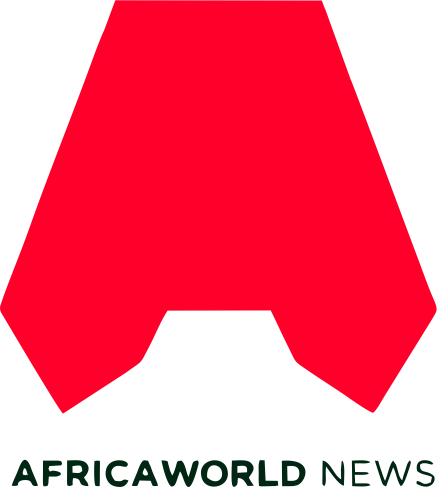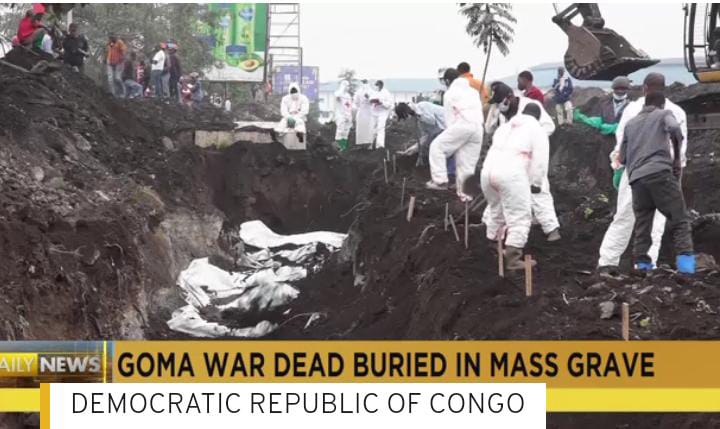DRC : Mass Burials In Goma As Families Demands For Peace
By Chinasaokwu Helen Okoro
Red Cross workers in Goma continued mass burials on Tuesday, a week after Rwanda-backed M23 rebels seized control of the city.
The Congolese interior minister, Jacquemin Shabani, stated that 2,000 bodies had been buried, while the WHO revised the official death toll to at least 900, excluding those still in morgues.
Families of the victims expressed deep grief and urged authorities to restore peace.
“We lost three people—some from a bomb, another was shot. We are devastated,” said Debors Zuzu, a grieving family member. “We have lived in fear for too long. If everyone dies, who will the leaders govern?”
At the ITIG cemetery, Elisha Dunia, who lost a child in the violence, called on the government to act. “We are heartbroken. We ask the president and our deputies to get involved in restoring peace in Goma.”
The M23 rebel group, backed by an estimated 4,000 Rwandan troops, has intensified its grip on eastern Congo, a region rich in minerals essential for global technology. This latest escalation has displaced hundreds of thousands, with many fleeing into Rwanda.
Last week, M23 announced plans to establish an administration in Goma, urging residents to resume normal life.
On Monday, they declared a unilateral ceasefire, effective Tuesday, citing humanitarian concerns. However, uncertainty looms as the conflict-ravaged ,city mourns its dead and grapples with ongoing instability.
What is the M23?
The M23 is one of dozens of armed groups active in eastern DRC, where militias have sown chaos for over three decades.
The conflict is a legacy of multistate wars that played out in Congo after the 1994 Rwandan genocide, in which as many as 1 million people, mainly of the Tutsi ethnic group, were killed by Hutu extremists. Tutsi rebels led by current Rwandan President Paul Kagame put an end to the killing, and many Hutu perpetrators fled across the border into Congo.
The M23, or March 23 movement, refers to the date of an earlier peace agreement the group claims the Congolese government failed to honor. The rebel group, led by Congolese Tutsi commanders, formed in 2012 and is a successor to earlier Tutsi-led rebellions. It briefly captured Goma the same year before being driven out.
Desperately poor, but rich in minerals used in electronics and mobile phones, eastern Congo is ethnically diverse. Many militias have origins in specific local communities.
After years of lying dormant, the M23 relaunched its rebellion in North Kivu in late 2021, capturing territory including a key border crossing into Uganda. By January 2022, it had mostly surrounded Goma, leaving a pocket of government-controlled territory around the city.
What do the rebels want?
M23 leaders say that they are fighting to protect ethnic minorities against a DRC government they accuse of fomenting hate speech and discrimination. Another key demand is the return of Congolese Tutsi refugees, many of whom live in Uganda and Rwanda, to Congo.
The DRC government, however, considers the M23 a “puppet” of Rwandan interests. President Felix Tshisekedi has vowed to retake Goma. “We will fight and we will triumph,” he said in an address to the nation on Wednesday evening.
What do the rebels want?
M23 leaders say that they are fighting to protect ethnic minorities against a DRC government they accuse of fomenting hate speech and discrimination. Another key demand is the return of Congolese Tutsi refugees, many of whom live in Uganda and Rwanda, to Congo.
The DRC government, however, considers the M23 a “puppet” of Rwandan interests. President Felix Tshisekedi has vowed to retake Goma. “We will fight and we will triumph,” he said in an address to the nation on Wednesday evening.
The region, with its large reserves of wealth, offers other opportunities to the rebels. With the capture of Goma, the M23 now has access to a key border city and a critical mineral smuggling route into Rwanda. A 2024 United Nations report estimated that the rebels smuggled at least 150 metric tons of coltan — used in electronics — into Rwanda last year.
How is Rwanda involved?
Rwanda provides material support to the M23, according to several reports by an independent panel of United Nations experts. It has troops in North Kivu — up to 4,000, according to the U.N. panel reports — and its special forces oversee M23 units. Drone imagery has captured troops regularly crossing the border into M23-controlled territory for years.
Rwanda has also deployed high-tech military equipment on the battlefield in North Kivu, including as mobile air-defense systems and precision-guided munitions.
The United Nations, including Security Council members such as the U.S., France and the United Kingdom, agree that Rwandan forces are operating in Congo. Rwanda’s government, however, has never publicly admitted to being involved.
Rwanda says the conflict has deeper roots that need to be addressed. They claim that militias such as the Democratic Forces for the Liberation of Rwanda (FDLR), a Hutu rebel group which includes some of those responsible for the Rwandan genocide, are still active in eastern Congo. Rwanda accuses the Congolese army of fighting alongside them, an accusation the Congolese deny.
What’s at stake?
The humanitarian impact of the M23 conflict has been enormous. Over 1 million people have been displaced over the years, with hundreds of thousands camping in dire conditions on the outskirts of Goma. Sexual violence, hunger and disease plague the camps, despite the efforts of aid groups.
The conflict now threatens to spiral, raising the specter of a replay of the two Congo wars — between 1996 and 1997, and 1998 and the early 2000s — which various researchers estimate led to 3 million to over 5 million deaths. During those two wars, nine African nations and some 20 armed groups fought each other, with the Second Congo War in particular considered to be one of the deadliest conflicts in history
What next?
The M23 and Rwandan troops are moving farther into the province of South Kivu, according to local reports on the ground. The U.N. and others are concerned that there could be a move on the city of Bukavu, which also lies on the Rwandan border.
The DRC government has repeatedly called for international sanctions against Rwanda for backing the M23. So far African and international diplomacy has had little impact.
Secretary of State Marco Rubio told Rwanda’s President Kagame that the U.S. is “deeply troubled” by the fighting. Countries including the U.K. and Germany have threatened to cancel aid to Rwanda. But still the fighting continues.
Those in the story
DRC
Rwanda
M23


